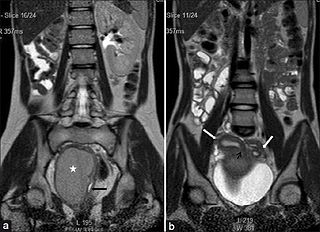 W
WThe uterus or womb is a major female hormone-responsive secondary sex organ of the reproductive system in humans and most other mammals. In the human, the lower end of the uterus, the cervix, opens into the vagina, while the upper end, the fundus, is connected to the fallopian tubes. It is within the uterus that the fetus develops during gestation. In the human embryo, the uterus develops from the paramesonephric ducts which fuse into the single organ known as a simplex uterus. The uterus has different forms in many other animals and in some it exists as two separate uteri known as a duplex uterus.
 W
WAn artificial uterus is a device that would allow for extracorporeal pregnancy by growing a fetus outside the body of an organism that would normally carry the fetus to term.
 W
WFemale hysteria was once a common medical diagnosis for women, which was described as exhibiting a wide array of symptoms, including anxiety, shortness of breath, fainting, nervousness, sexual desire, insomnia, fluid retention, heaviness in the abdomen, irritability, loss of appetite for food or sex, (paradoxically) sexually forward behaviour, and a "tendency to cause trouble for others". It is no longer recognized by medical authorities as a medical disorder. Its diagnosis and treatment were routine for hundreds of years in Western Europe.
 W
WHysteria is a pejorative term that colloquially means ungovernable emotional excess and can refer to a temporary state of mind or emotion; however, in the 19th century hysteria was considered a diagnosable physical illness in females, and then in the 20th century shifted to a mental illness. Many influential persons such as Sigmund Freud and Jean-Martin Charcot dedicated research to hysteria patients. Currently, most doctors practicing Western medicine do not accept hysteria as a medical diagnosis. The blanket diagnosis of hysteria has been fragmented into myriad medical categories such as epilepsy, histrionic personality disorder, conversion disorders, dissociative disorders, or other medical conditions. Furthermore, social deviances, such as deciding not to wed, are no longer considered psychological disorders.
 W
WHerlyn-Werner-Wunderlich syndrome, also known as OHVIRA is an extremely rare syndrome characterized by a congenital birth defect of the lower abdominal and pelvic organs. It is a type of abnormality of the Müllerian ducts.
 W
WThe uterine artery is an artery that supplies blood to the uterus in females.
 W
WThe uterine cavity is the inside of the uterus.
 W
WUterine glands or endometrial glands are tubular glands, lined by ciliated columnar epithelium, found in the functional layer of the endometrium that lines the uterus. Their appearance varies during the menstrual cycle. During the proliferative phase, uterine glands appear long due to estrogen secretion by the ovaries. During the secretory phase, the uterine glands become very coiled with wide lumens and produce a glycogen-rich secretion. This change corresponds with an increase in blood flow to spiral arteries due to increased progesterone secretion from the corpus luteum. During the pre-menstrual phase, progesterone secretion decreases as the corpus luteum degenerates, which results in decreased blood flow to the spiral arteries. The functional layer of the uterus containing the glands becomes necrotic, and eventually sloughs off during the menstrual phase of the cycle.
 W
WThe uterine horns are the points where the uterus and the fallopian tubes meet. They are one of the points of attachment for the round ligament of uterus.
 W
WThe uterine microbiome is the commensal, nonpathogenic, bacteria, viruses, yeasts/fungi present in a healthy uterus, amniotic fluid and endometrium and the specific environment which they inhabit. It has been only recently confirmed that the uterus and its tissues are not sterile. Due to improved 16S rRNA gene sequencing techniques, detection of bacteria that are present in low numbers is possible. Using this procedure that allows the detection of bacteria that cannot be cultured outside the body, studies of microbiota present in the uterus are expected to increase.
 W
WThe uterine veins are tributaries of the internal iliac veins. They are found in the cardinal ligaments.
 W
WThe uterine plexuses lie along the sides and superior angles of the uterus between the two layers of the broad ligament, and communicate with the ovarian and vaginal plexuses.
 W
WThe uterosacral ligaments belong to the major ligaments of uterus.